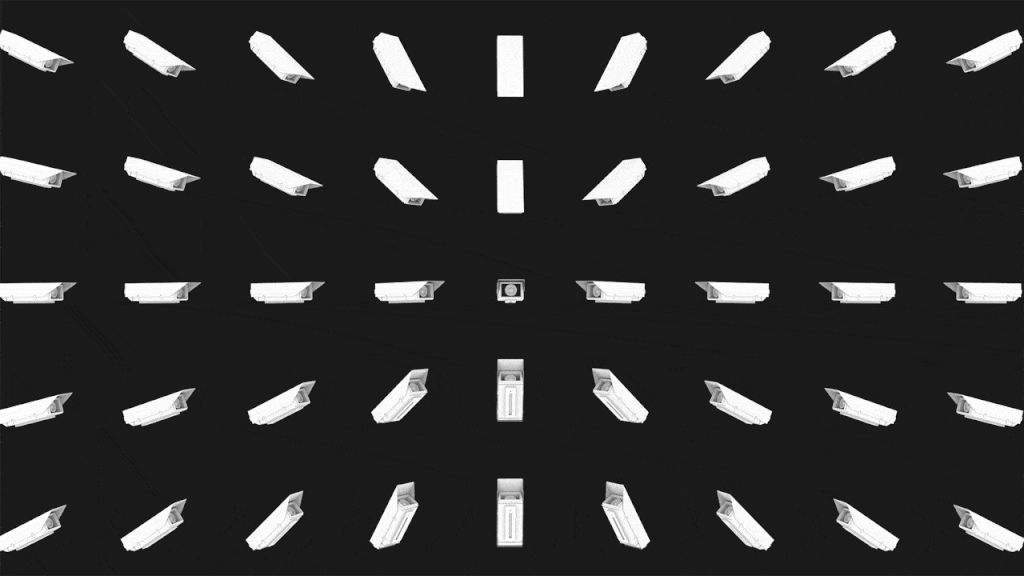The word “panopticon” comes from the Greek “panoptes”, meaning “all-seeing”. Similarly, a panopticon building is designed such that one person can view every other person in the building. The original idea for my game came from the idea of a panopticon, therefore I should do my best to research them.
Origins:
The original concept of a panopticon was made by philosopher Jeremy Bentham, as a theoretical prison design to dissuade prisoners from bad behaviour – the concept founded on the prisoners constantly feeling “watched”. Although the single parole officer charged with watching the prisoners can’t view all the prisoners at once, if the prisoners of the panopticon prison could be seen, but never knew when they were seen, then they would need to act like they were constantly being watched.
Its origins why panopticons are usually linked to prisons.

Willey Riley’s sketch of Jeremy Bentham’s panopticon prison, 1791.
Modern Panopticons
Now that I’ve looked at the origins of the panopticon, I want to have a look at modern ones and how similar/dissimilar they are.
Work Panopticons
Over the years, companies’ priorities have switched more and more to monitoring their employees – and though the reason given is always to ensure “productivity” is being upheld, it sometimes costs productivity in doing so. Humans who are happy, healthy, and enthusiastic about the work they do will always be more productive than exhuasted, worn-out ones. During the COVID-19 Lockdown in 2020, work productivity skyrocketed, as people were allowed to work in a comforting space and could spend more time with friends and family – not to mention cutting out commute. Despite this, when Lockdown ended, there was an emphasis on coming back to office. Companies did not like that they couldn’t monitor their employees, were even outraged on the implication that, if someone had finished their work early, they could clock off sooner under the guise of still being logged in. There was additional measures put in place that if a mouse rested too long on the screen, a notification would be sent to a higher-up saying that the employee was no longer working.
A more specific example is the company Amazon. Amazon uses monitoring technologies to surveil their workers and track their movements and productivity – and it is also infamous for being one of the worst, most dehumanising companies to work for. Employees are tagged with personal sat-navs that tell them the most direct route to to shelve goods, and are set target times for warehouse journeys. If an employee is behind schedule, they will recieve a text reminding them to reach their target or risk being fired. In the packing lines, machines measure whether packers are meeting targets, and foremen are tasked with surveying the area to monitor employees for minor offences, such as speaking to one another, pausing after a tough packing job, how often an employee goes to the bathroom, and other instances of “time theft”, with these depots designed to make surveillance easier with high bridges so these foremen can look down and monitor. This is very reminiscent of a panopticon, only this time ensuring that all workers keep productivity – those who fall behind are fired and replaced.
Head, S. (2014). Worse than Wal-Mart: Amazon’s sick brutality and secret history of ruthlessly intimidating workers. [online] Salon. Available at: https://www.salon.com/2014/02/23/worse_than_wal_mart_amazons_sick_brutality_and_secret_history_of_ruthlessly_intimidating_workers/.
Technology Panopticons
These days, the philosophy of panopticons have shifted to a focus on technology, with a particular emphasis on social media as a “reverse panopticon” – being that it is controlled at the centre and surrounded by those who watch.
It could, however, be argued that social media exists as a traditional panopticon as well. Companies collect data on us, not to monitor and control us, but to sell to us – advertisements that appeal to what we want and need. For example Facebook, a popular social media, has a data policy to collect any digital traces left on their platform for reasons such as “to provide, improve, and develop services”, “communicate with you”, “show and measure ads and services”, and “promote safety and security”. However, as a result of the change of ownership, they reserve the right to “transfer your information to the new owner”, so that the digital data does not belong to you anymore. Even deleting your account will not get rid of the data they have on you. The surveillence definitely rings of a panopticon: on most platforms, companies are trying to get and sell your data – you are being constantly watched.
Additionally, social media is not something one can “opt out” of easily – more and more so through the years. There is a social pressure to make and keep various accounts to communicate and to keep up to date with the latest trends and jokes, in an era where we’re more heavily reliant on digital media for entertainment, news, advertisments, and communication than any other. Not being a part of this keeps you out of the loop, and risks ostracisation. Then there is the more practical side – businesses, work portfolios, and networking is also done online, and without these, many doors to jobs will be closed. Like a prison, social media is designed to entrap and hold us in place.
Romele, A., Emmenegger, C., Gallino, F. and Gorgone, D. (n.d.). Technologies of Voluntary Servitude (TovS): a post–Foucauldian Perspective on Social Media. [online] Available at: http://www.albertoromele.com/wp-content/uploads/2015/08/ToVS-1.pdf.
My Game
My game cannot be a true panopticon, because the player needs to be given a fair chance to hide in blind spots and vents. The feeling of paranoia and where I draw the parallel to panopticons however, is that when they do have to pass tight blind spots and cameras, they do not know whether the camera is being watched.

Leave a Reply